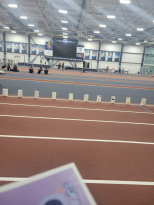Pet Best friend
Samantha McCarthy is a junior majoring in human development and family studies. When Samantha graduates, she wishes to work at a nonprofit organization for education reform, with an emphasis on special needs and autism.
The lab she raises, named Diego, is nine months old. Diego is with Samantha for a total of 18 months, and has already learned 27 commands.
In addition to McCarthy a State College couple named Cathy Taylor and Mark Greenberg also became SSD volunteers.
Cathy became interested in volunteering to raise a service dog because of her profession as a child psychologist. Their service puppy Rachel is five months old.
Rachel greets as many as 8-10 children a day at Cathy’s work office. She takes walks and learns behavior modification techniques throughout the day. Cathy was inspired by seeing clients come in and out of her office with service dogs. Cathy found it fascinating that dogs can sense things, such as children with autism and panic attacks.
Mark and Cathy are both very emotionally connected with Rachel. According to Mark, half of the dogs that go through the first 18 months of training don’t make it to be certified as service dogs. Cathy and Mark are first on the list to adopt Rachel. She has to learn 50 skills in 18 months, followed by 6 months of advance training. When she gets to the advance training, Rachel will be paired with a permanent owner based on her personality. Verbal and nonverbal commands are taught to Rachel. Rachel is also being trained so that she may be paired up as a fire dog, police dog, or to be able to sense seizure disorders.
Mark talked about how difficult it can be to train Rachel because she still acts like a puppy. They have a clicker reinforcement tool so that Rachel is rewarded with a treat when she does a trained action. Every behavior begins with a hand-sign and then a verbal cue.
Sit, stand, come, leave it, get busy, down, enter and all the way through are just some of the commands Rachel knows. During the first two months of advance training, they will teach her how to open doors and turn down the lights.
Mark told a story about how he and Cathy recently went to a Broadway musical and met a guy there who was sight-impaired with a service dog. He said that just the sight of the dog made people more aware that the guy was disabled and the guy talked about it making his life much easier.
All SSD volunteers use a clicker tool to reinforce an action so that the dog will remember to do the commanded action. The volunteers use the clicker on the puppies right from the beginning of being with them. SSD has three training classes, including one class on clicker training to get the dogs to respond. The treats reinforce the behavior. The reinforcement is a constant skill. Mark said, “It’s fun having her around because it’s all altruistic; paying it forward and it’s not self-serving.”








